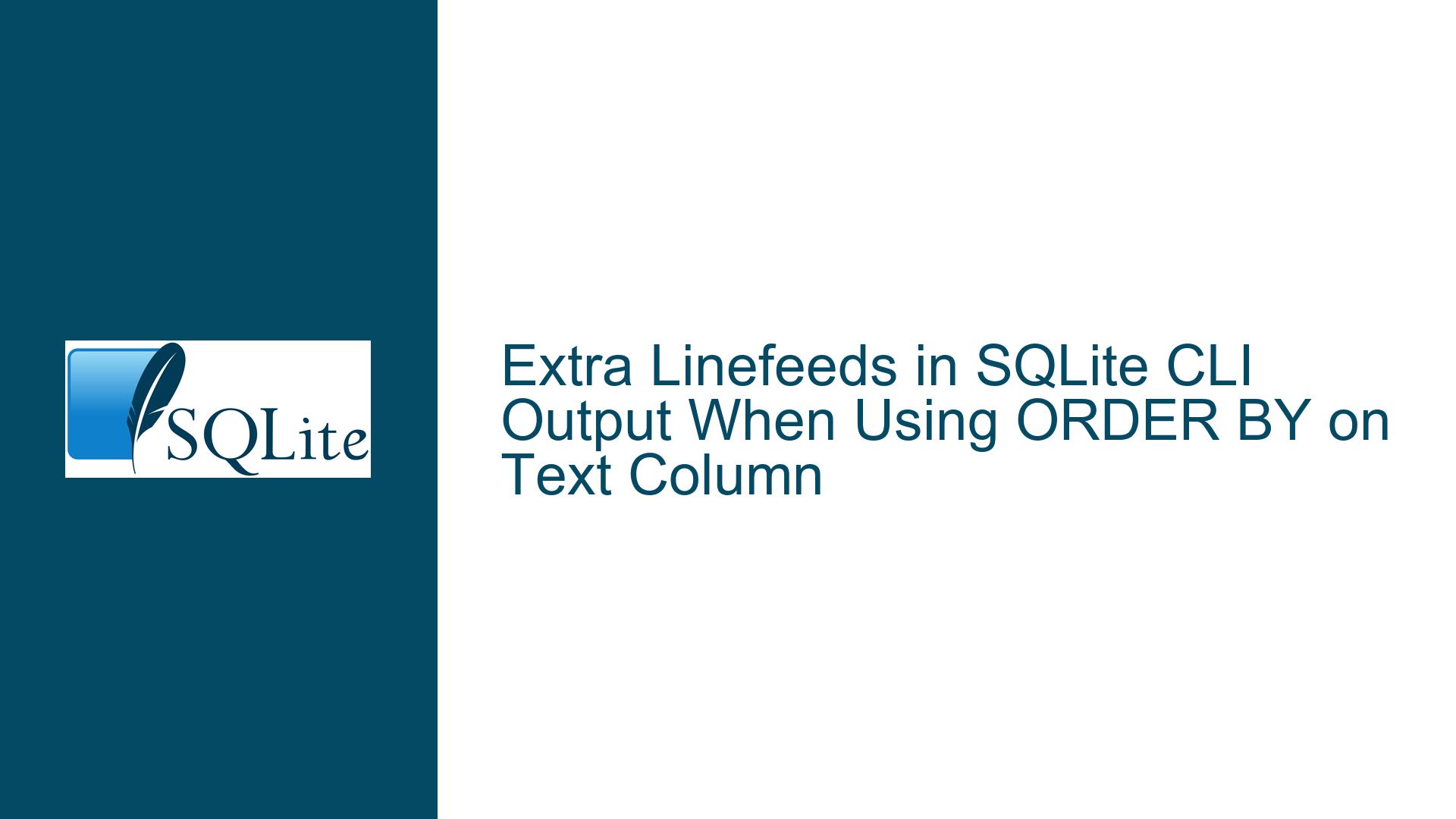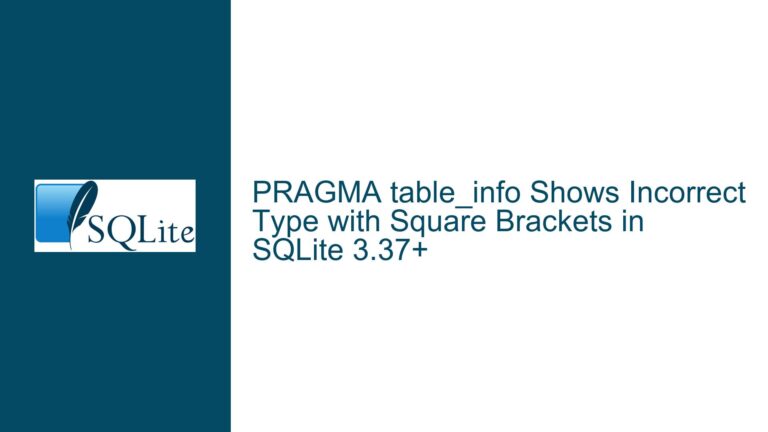Extra Linefeeds in SQLite CLI Output When Using ORDER BY on Text Column
Understanding and Resolving Extra Linefeeds in SQLite CLI Output When Sorting by Text Columns
Unexpected Linefeeds in Columnar Output Due to Wrapped Text
1. Root Cause: Terminal Wrapping Behavior with Variable-Length Text Columns
The appearance of unexpected linefeeds in SQLite CLI output when using ORDER BY on a text column (e.g., Title) stems from how the SQLite command-line interface (CLI) dynamically adjusts column widths and handles text wrapping. Unlike numeric columns (e.g., AlbumId), text columns often contain variable-length data. When a sorted text column contains entries that exceed the available terminal width, the CLI wraps the text to fit the display. This wrapping introduces visual artifacts: a wrapped line is followed by a blank line, creating the illusion of an "extra linefeed."
The behavior is particularly noticeable when:
- The sorted column contains long text entries (e.g.,
20th Century Masters - The Millennium Collection: The Best of Scorpions). - The terminal window is narrow, forcing the CLI to wrap text.
- The
ORDER BYclause changes the order of rows, exposing long text entries earlier in the result set.
For example, when sorting by AlbumId, the Title column’s entries are not the primary sort key. The CLI may allocate more horizontal space to the Title column by default, reducing the likelihood of wrapping. In contrast, sorting by Title forces the CLI to prioritize the sorted column’s display width, which may shrink other columns (e.g., AlbumId) and trigger wrapping for long titles.
2. Contributing Factors: CLI Configuration, Terminal Width, and Data Characteristics
Three primary factors interact to produce the extra linefeeds:
SQLite CLI Display Modes and Column Widths
The SQLite CLI uses acolumndisplay mode by default, which attempts to fit all columns within the terminal width. Column widths are determined dynamically based on the data in the result set. When a column contains long text, the CLI may reduce its allocated width, forcing wrapping.Terminal Window Dimensions
A narrow terminal window exacerbates wrapping. For instance, if the terminal is 80 characters wide and theTitlecolumn’s entries require 100 characters, the CLI wraps the text into multiple lines. Each wrapped line consumes vertical space, creating gaps between rows.Data Distribution in Sorted Result Sets
The order of rows affects how the CLI calculates column widths. Sorting byTitlesurfaces long entries early in the result set, causing the CLI to allocate insufficient width for subsequent columns. This forces aggressive wrapping even for shorter titles.
3. Mitigation Strategies: Adjusting CLI Settings, Terminal Configuration, and Query Design
To eliminate unwanted linefeeds, apply the following solutions:
A. Increase Terminal Width
Expand the terminal window horizontally to provide more space for columns. For example, a width of 120 characters often accommodates typical text columns without wrapping.
B. Configure SQLite CLI Display Modes
Use
.mode boxor.mode table
Switch to a tabular display mode that better handles long text:.mode box SELECT AlbumId, Title FROM albums ORDER BY Title LIMIT 5;The
boxmode draws borders around cells, preventing wrapped lines from visually merging with adjacent rows.Set Fixed Column Widths
Manually define column widths using.width:.width 10 60 SELECT AlbumId, Title FROM albums ORDER BY Title LIMIT 5;This allocates 10 characters to
AlbumIdand 60 characters toTitle, reducing wrapping.Disable Column Truncation
Use.mode columnwith.nullvalue ""and.printto preserve formatting:.mode column .nullvalue "" .print "AlbumId Title" SELECT AlbumId, Title FROM albums ORDER BY Title LIMIT 5;
C. Modify Queries to Shorten Text Output
Truncate long text entries using SUBSTR or enforce maximum lengths:
SELECT AlbumId, SUBSTR(Title, 1, 30) AS ShortTitle FROM albums ORDER BY Title LIMIT 5;
D. Redirect Output to a File
Use .once to write results to a file, bypassing terminal constraints:
.once output.txt
SELECT AlbumId, Title FROM albums ORDER BY Title LIMIT 5;
E. Verify Data for Hidden Linefeeds
Confirm that the Title column does not contain embedded linefeed characters (\n):
SELECT Title FROM albums WHERE Title LIKE '%' || CHAR(10) || '%';
If linefeeds are present, sanitize the data with REPLACE:
UPDATE albums SET Title = REPLACE(Title, CHAR(10), ' ') WHERE Title LIKE '%' || CHAR(10) || '%';
By systematically adjusting CLI settings, terminal dimensions, and query design, users can eliminate extraneous linefeeds and achieve cleaner, more readable output.






